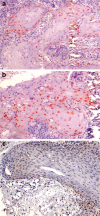p53: Revealing the Unusual Suspect: a Study and Field Cancerization Minireview
- PMID: 25114469
- PMCID: PMC4116548
- DOI: 10.1007/s13193-014-0305-8
p53: Revealing the Unusual Suspect: a Study and Field Cancerization Minireview
Figures



References
-
- Cruz IB, Snijders PJF, Meijer CJ, Braakhuis BJ, Snow GB, et al. p53 expression above the basal cell layer in oral mucosa is an early event of malignant transformation and has predictive value for developing oral squamous cell carcinoma. J Pathol. 1998;184:360–368. doi: 10.1002/(SICI)1096-9896(199804)184:4<360::AID-PATH1263>3.0.CO;2-H. - DOI - PubMed
-
- Bedi GC, Westra WH, Gabrielson E, Koch W, Sidransky D. Multiple head and neck tumors: evidence for a common clonal origin. Cancer Res. 1996;56:2484–2487. - PubMed
LinkOut - more resources
Full Text Sources
Other Literature Sources
Research Materials
Miscellaneous
